Military technology plays a pivotal role in shaping geopolitical conflicts and strategies by enhancing the effectiveness and precision of military operations. Innovations such as drones, cyber warfare capabilities, and advanced missile systems not only alter the balance of power but also compel nations to adapt their defense policies and military strategies to maintain competitiveness in an ever-evolving landscape.

How does military technology influence geopolitical conflicts?
Military technology significantly shapes geopolitical conflicts by enhancing the effectiveness and precision of military operations. Innovations in weaponry and surveillance alter strategies, power balances, and international relations, making technology a critical factor in modern warfare.
Increased precision in warfare
The advancement of military technology has led to more precise targeting capabilities, reducing collateral damage and increasing operational efficiency. Technologies such as drones and guided munitions allow for strikes with minimal civilian impact, which can influence public perception and international response.
For instance, the use of precision-guided munitions in conflicts has shown a marked decrease in unintended casualties, often cited as a key advantage in urban warfare scenarios. This precision can shift the moral high ground in conflicts, affecting diplomatic negotiations and domestic support.
Shift in power dynamics
Military technology can dramatically alter the balance of power between nations, enabling smaller states to challenge larger ones. Countries that invest in advanced technologies, such as cyber warfare capabilities or missile defense systems, can deter aggression from more powerful adversaries.
For example, nations like North Korea have leveraged missile technology to assert themselves on the global stage, despite their limited conventional forces. This shift can lead to new geopolitical alliances as nations seek partnerships to counterbalance technologically superior foes.
Impact on international alliances
The evolution of military technology influences the formation and stability of international alliances. Countries often band together to share technological advancements and enhance collective security, leading to new defense agreements and partnerships.
For instance, NATO’s focus on integrating advanced military technologies among member states has strengthened its collective defense posture. As nations prioritize technological capabilities, alliances may shift, with countries seeking partners that can provide access to cutting-edge military innovations.
Case studies from recent conflicts
Recent conflicts illustrate the profound impact of military technology on geopolitical strategies. In the Syrian Civil War, the use of drones for surveillance and targeted strikes has transformed operational tactics for both state and non-state actors.
Similarly, the ongoing conflict in Ukraine has highlighted the role of advanced weaponry, such as anti-tank missiles and artillery systems, in shaping battlefield outcomes. These examples underscore how military technology not only affects immediate conflict dynamics but also influences broader geopolitical relationships and strategies.
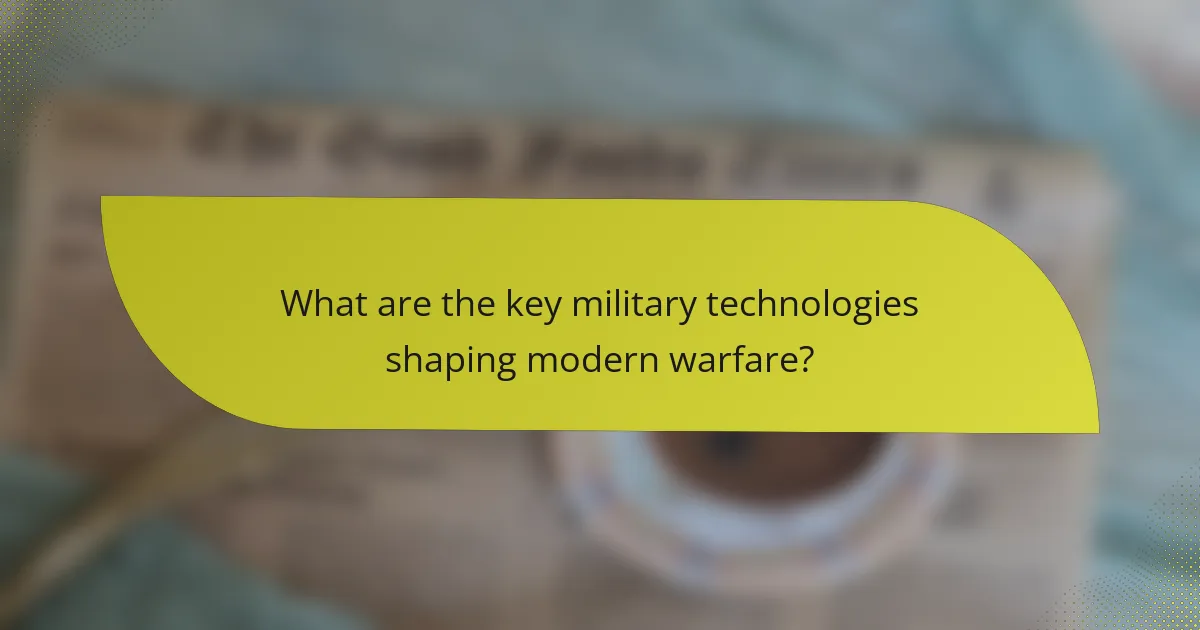
What are the key military technologies shaping modern warfare?
Key military technologies that are shaping modern warfare include drones, cyber warfare capabilities, artificial intelligence, and advanced missile systems. These innovations significantly influence military strategies and geopolitical conflicts by enhancing operational efficiency and altering the balance of power.
Drones and unmanned systems
Drones and unmanned systems have transformed reconnaissance and combat operations. They allow for real-time surveillance and targeted strikes without risking human lives, making them invaluable in modern conflicts.
Countries like the United States and Israel have extensively deployed drones for intelligence-gathering and precision strikes, showcasing their effectiveness in both urban and remote environments. The ability to operate in contested airspace with minimal risk has made drones a cornerstone of contemporary military strategy.
Cyber warfare capabilities
Cyber warfare capabilities involve the use of digital attacks to disrupt or damage enemy systems. This includes hacking, data breaches, and the deployment of malware to cripple critical infrastructure.
As nations increasingly rely on digital networks, the potential for cyber attacks to influence geopolitical outcomes grows. For instance, state-sponsored cyber operations have been used to interfere with elections and disrupt essential services, highlighting the strategic importance of cybersecurity in modern warfare.
Artificial intelligence applications
Artificial intelligence (AI) applications in military contexts enhance decision-making, logistics, and operational efficiency. AI can analyze vast amounts of data quickly, providing commanders with actionable insights in real-time.
Examples include AI-driven predictive maintenance for military equipment and autonomous systems that can operate with minimal human intervention. However, ethical considerations and the potential for unintended consequences must be carefully managed as AI technologies evolve.
Advanced missile systems
Advanced missile systems, including hypersonic and precision-guided munitions, represent a significant leap in military capability. These systems can strike targets with high accuracy at unprecedented speeds, complicating defense strategies.
Countries like Russia and the United States are investing heavily in these technologies, which can alter the strategic landscape by enabling rapid response to threats. The development of missile defense systems is equally crucial to countering these advanced threats, creating a complex arms race in missile technology.
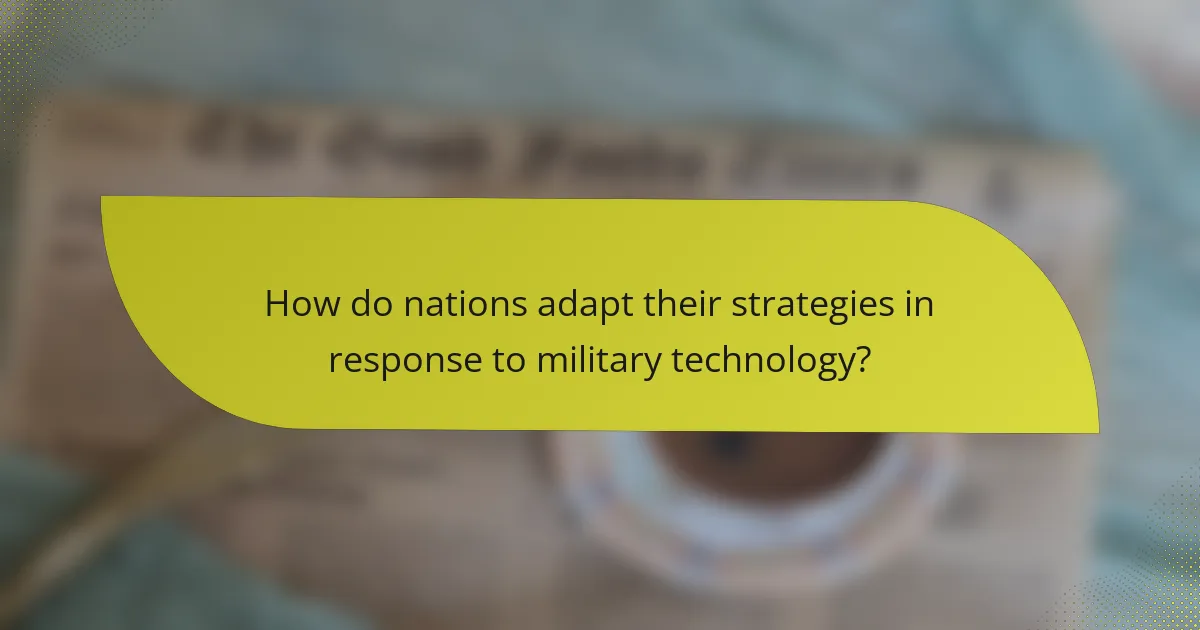
How do nations adapt their strategies in response to military technology?
Nations adapt their strategies to military technology by modernizing defense policies, investing in research and development (R&D), and changing training and recruitment practices. These adaptations ensure that military forces remain effective and competitive in a rapidly evolving technological landscape.
Modernization of defense policies
Modernization of defense policies involves updating military doctrines to incorporate new technologies and tactics. For instance, countries may shift focus from traditional ground forces to cyber warfare and unmanned systems, reflecting the growing importance of information dominance.
Additionally, nations often reassess alliances and partnerships to enhance collective security in light of technological advancements. This may include joint exercises and sharing intelligence to better prepare for potential conflicts.
Investment in R&D
Investment in research and development is crucial for nations to stay ahead in military technology. Governments typically allocate significant portions of their defense budgets—often in the range of 5-10%—to R&D initiatives aimed at developing advanced weaponry, surveillance systems, and cyber capabilities.
Countries may also collaborate with private industry and academic institutions to foster innovation. This public-private partnership can accelerate the development of cutting-edge technologies, such as artificial intelligence and autonomous systems.
Training and recruitment changes
Training and recruitment changes are essential for integrating new technologies into military operations. Armed forces increasingly prioritize skills in data analysis, cyber operations, and the use of advanced weapon systems during recruitment processes.
Moreover, ongoing training programs are adapted to include simulations and exercises that reflect modern warfare scenarios, ensuring personnel are proficient with the latest technologies. This approach helps maintain operational readiness and effectiveness in diverse combat environments.
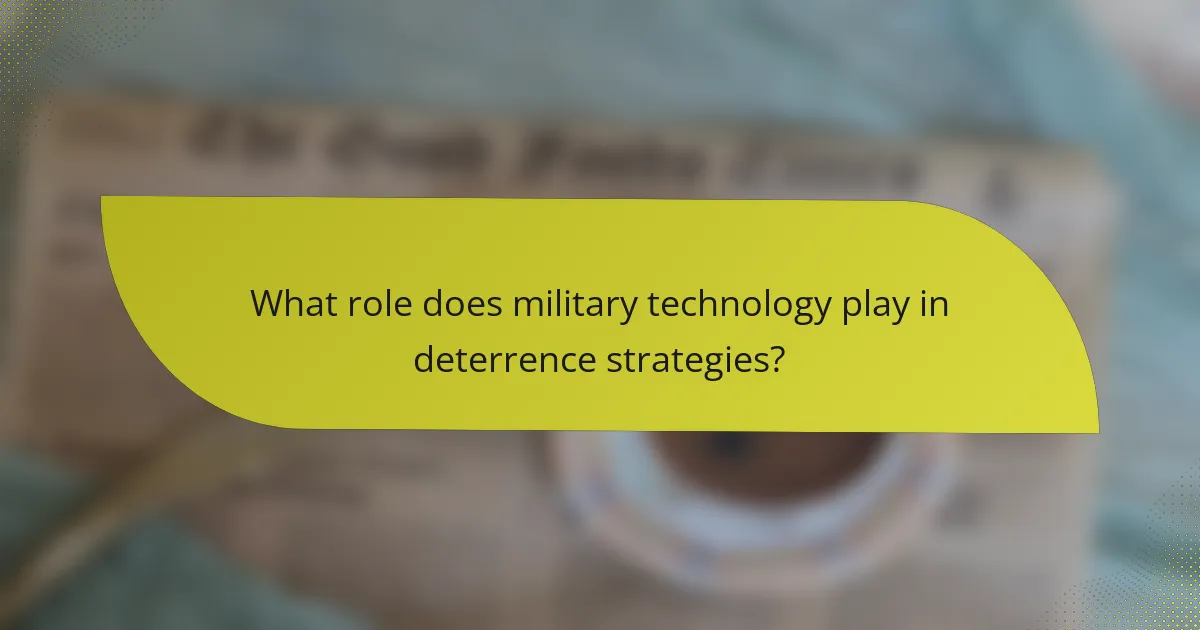
What role does military technology play in deterrence strategies?
Military technology is crucial in deterrence strategies as it enhances a nation’s ability to prevent conflict through the threat of significant retaliation. Advanced weaponry, surveillance systems, and cyber capabilities create a landscape where potential aggressors weigh the consequences of their actions against the technological prowess of their adversaries.
Enhancing deterrent capabilities
Modern military technology significantly enhances deterrent capabilities by providing nations with advanced systems that can respond swiftly and effectively to threats. For instance, precision-guided munitions and missile defense systems can neutralize potential attacks, thereby reinforcing a nation’s defensive posture.
Additionally, the integration of artificial intelligence in military operations allows for faster decision-making and improved situational awareness. This technological edge can deter adversaries by making it clear that any aggression will be met with a calculated and effective response.
Influencing nuclear strategy
Military technology plays a pivotal role in shaping nuclear strategy by affecting the balance of power and the credibility of deterrence. The development of hypersonic weapons and advanced delivery systems can alter how states perceive their nuclear capabilities and those of their rivals.
Moreover, advancements in missile defense technology can lead to a reassessment of nuclear arsenals, as nations may feel compelled to enhance their stockpiles or develop new strategies to ensure their deterrent remains credible. This dynamic can create an arms race, as countries strive to maintain a technological advantage.
Case studies of deterrence in action
One notable case study is the Cold War, where the United States and the Soviet Union relied heavily on military technology to deter nuclear conflict. The development of intercontinental ballistic missiles (ICBMs) and submarine-launched ballistic missiles (SLBMs) established a balance of terror that prevented direct confrontation.
Another example is the ongoing tensions in the Asia-Pacific region, where advancements in missile technology by North Korea have prompted South Korea and Japan to enhance their own military capabilities. This technological escalation demonstrates how military advancements can influence regional security dynamics and deterrence strategies.
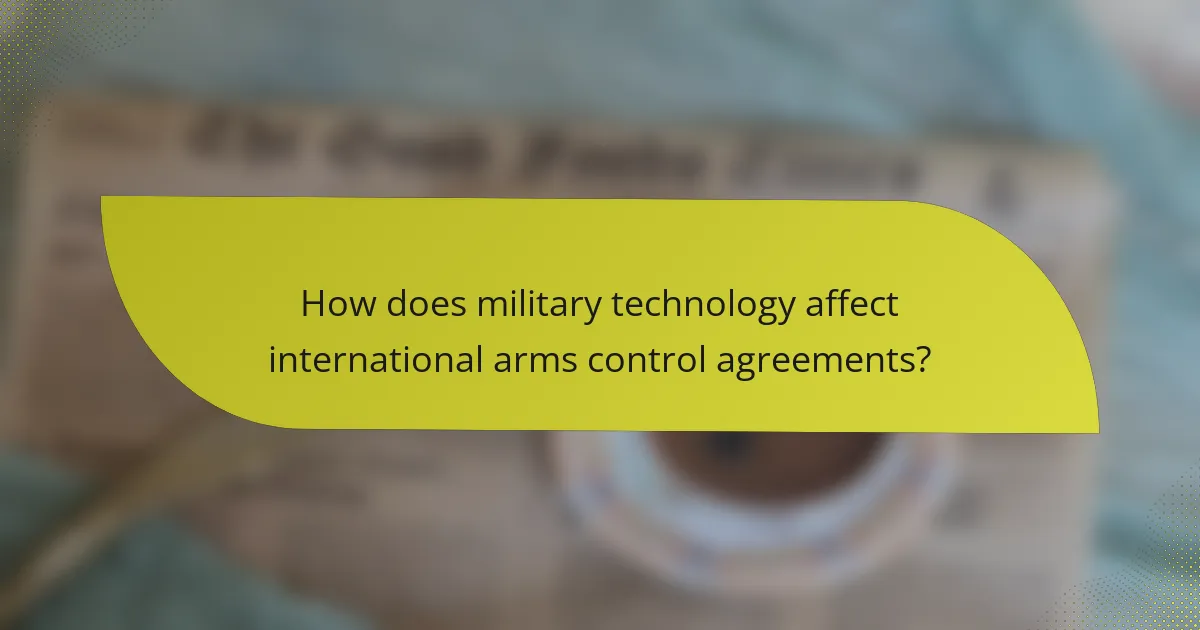
How does military technology affect international arms control agreements?
Military technology significantly influences international arms control agreements by altering the landscape of verification, negotiation dynamics, and compliance. Advances in technology can create challenges in monitoring compliance and may lead to shifts in power balances that affect treaty discussions.
Challenges in verification
Verification of compliance with arms control agreements has become increasingly complex due to advancements in military technology. Technologies such as stealth capabilities and cyber warfare tools can obscure the true nature of a state’s military capabilities, making it difficult to assess compliance accurately.
Additionally, the proliferation of dual-use technologies, which can serve both civilian and military purposes, complicates verification efforts. States may exploit ambiguities in these technologies to evade scrutiny, leading to mistrust among parties involved in arms control agreements.
Impact on treaty negotiations
The rapid evolution of military technology can shift the balance of power, influencing the negotiation process for arms control treaties. Countries may be less willing to commit to agreements if they perceive that their adversaries possess superior technology that could undermine their security.
Moreover, technological advancements can lead to new strategic considerations, prompting states to seek more flexible terms in treaties. This can result in prolonged negotiations or even the collapse of talks if parties cannot agree on acceptable terms regarding emerging technologies.
Examples of recent arms control discussions
Recent arms control discussions have highlighted the impact of military technology on treaty frameworks. The New START treaty between the United States and Russia, for example, has been influenced by developments in missile defense systems and hypersonic weapons, prompting both sides to reassess their strategic postures.
Another example is the discussions surrounding the Treaty on the Prohibition of Nuclear Weapons, where advancements in nuclear delivery systems have raised concerns about compliance and verification. These discussions illustrate the ongoing challenges posed by military technology in shaping effective arms control agreements.
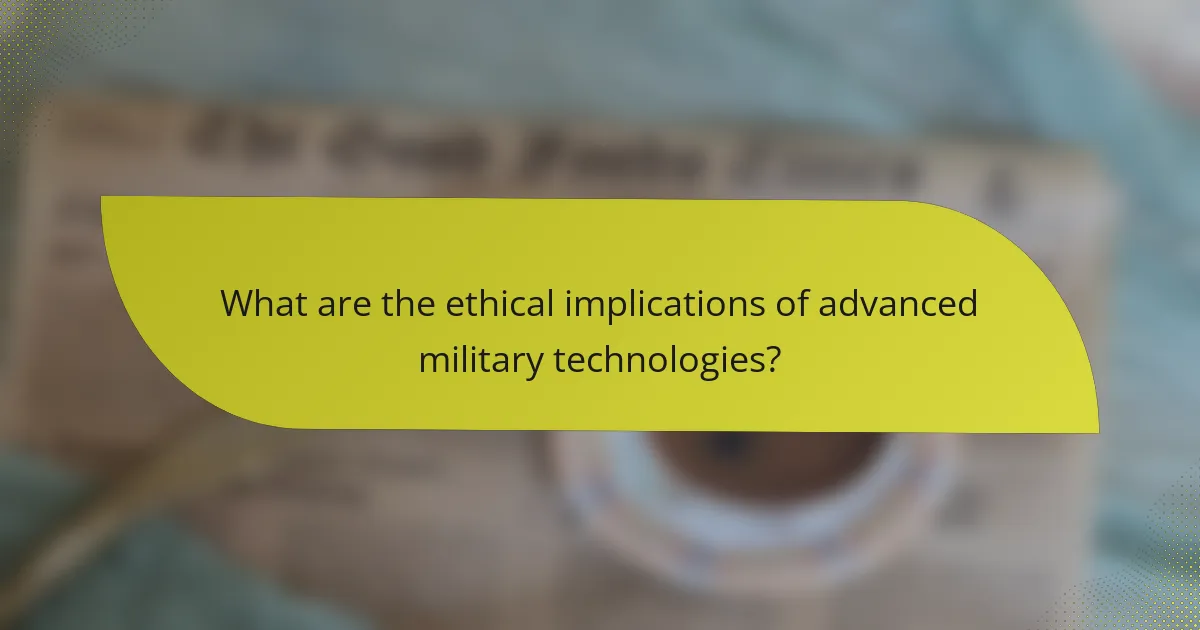
What are the ethical implications of advanced military technologies?
Advanced military technologies raise significant ethical concerns, particularly regarding their impact on warfare and civilian safety. Issues such as autonomous weapons, surveillance capabilities, and cyber warfare challenge traditional moral frameworks and necessitate new regulations.
Autonomous Weapons Systems
Autonomous weapons systems, often referred to as killer robots, can operate without human intervention. The ethical implications include the potential for reduced accountability in warfare, as decisions to engage targets may be made by algorithms rather than human judgment. This raises concerns about the reliability of these systems in distinguishing between combatants and civilians.
Countries must consider the legal and moral ramifications of deploying such technologies. For instance, the lack of clear guidelines on the use of force by autonomous systems can lead to violations of international humanitarian law. A robust regulatory framework is essential to govern their development and use.
Surveillance and Privacy
Advanced military technologies enhance surveillance capabilities, which can infringe on personal privacy. The use of drones and satellite imagery allows for extensive monitoring of populations, often without consent. This raises ethical questions about the balance between national security and individual rights.
Governments should implement strict oversight and transparency measures to protect citizens’ privacy. Establishing clear policies on data collection and usage can help mitigate the risks associated with surveillance technologies.
Cyber Warfare
Cyber warfare introduces unique ethical dilemmas, particularly regarding the potential for collateral damage. Attacks on critical infrastructure can disrupt essential services, affecting civilian populations. The ambiguity in attributing cyber attacks complicates accountability and response strategies.
To navigate these challenges, nations must develop international norms and agreements governing cyber operations. Establishing clear rules of engagement can help prevent escalation and protect civilian interests in the digital domain.
